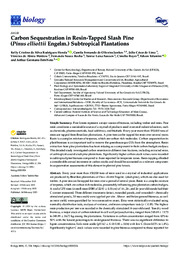Carbon Sequestration in Resin-Tapped Slash Pine (Pinus elliottii Engelm.) Subtropical Plantations.
Carbon Sequestration in Resin-Tapped Slash Pine (Pinus elliottii Engelm.) Subtropical Plantations.
Author(s): RODRIGUES-HONDA, K. C. da S.; JUNKES, C. F. de O.; LIMA, J. C.; WALDOW, V. de A.; ROCHA, F. S.; SAUSEN, T. L.; BAYER, C.; TALAMINI, E.; FETT-NETO, A. G.
Summary: Every year more than 150,000 tons of resin used in a myriad of industrial applications are produced by Brazilian plantations of Pinus elliottii Engelm. (slash pine), which are also used for timber. A pine tree can be tapped for resin over a period of several years. Resin is a complex mixture of terpenes, which are carbon-rich molecules, presumably influencing pine plantation carbon budgets. A total of 270 trees (overall mean DBH of 22.93 ± 0.11 cm) of 14-, 24-, and 26-year-old stands had their C content measured. Three different treatments (intact, wounded panels, and wounded + chemically stimulated panels, 30 trees each) were applied per site. Above- and belowground biomass, as well as resin yield, were quantified for two consecutive years. Data were statistically evaluated using normality distribution tests, analyses of variance, and mean comparison tests (p ≤ 0.05). The highest resin production per tree was recorded in the chemically stimulated 14-year-old stand. Tree dry wood biomass, a major stock of carbon retained in cell wall polysaccharides, ranged from 245.69 ± 11.73 to 349.99 ± 16.73 kg among the plantations. Variations in carbon concentration ranged from 43% to 50% with the lowest percentages in underground biomass. There was no significant difference in lignin concentrations. Soils were acidic (pH 4.3 ± 0.10?5.83 ± 0.06) with low C (from 0.05% to 1.4%). Significantly higher C stock values were recorded in pine biomass compared to those reported for temperate zones. Resin-tapping biomass yielded considerable annual increments in C stocks and should be included as a relevant component in C sequestration assessments of planted pine forests.
Publication year: 2023
Types of publication: Journal article
Unit: Embrapa Cerrados
Keywords: Carbono, Pinus Elliottii, Resina, Sequestro de carbono
Observation
Some of Embrapa's publications are published as ePub files. To read them, use or download one of the following free software options to your computer or mobile device. Android: Google Play Books; IOS: iBooks; Windows and Linux: Calibre.
Access other publications
Access the Agricultural Research Database (BDPA) to consult Embrapa's full library collection and records.
Visit Embrapa Bookstore to purchase books and other publications sold by Embrapa.

